Jonas Stein
From Classical Data to Quantum Advantage -- Quantum Policy Evaluation on Quantum Hardware
Sep 09, 2025Abstract:Quantum policy evaluation (QPE) is a reinforcement learning (RL) algorithm which is quadratically more efficient than an analogous classical Monte Carlo estimation. It makes use of a direct quantum mechanical realization of a finite Markov decision process, in which the agent and the environment are modeled by unitary operators and exchange states, actions, and rewards in superposition. Previously, the quantum environment has been implemented and parametrized manually for an illustrative benchmark using a quantum simulator. In this paper, we demonstrate how these environment parameters can be learned from a batch of classical observational data through quantum machine learning (QML) on quantum hardware. The learned quantum environment is then applied in QPE to also compute policy evaluations on quantum hardware. Our experiments reveal that, despite challenges such as noise and short coherence times, the integration of QML and QPE shows promising potential for achieving quantum advantage in RL.
Quantum Boltzmann Machines using Parallel Annealing for Medical Image Classification
Jul 18, 2025Abstract:Exploiting the fact that samples drawn from a quantum annealer inherently follow a Boltzmann-like distribution, annealing-based Quantum Boltzmann Machines (QBMs) have gained increasing popularity in the quantum research community. While they harbor great promises for quantum speed-up, their usage currently stays a costly endeavor, as large amounts of QPU time are required to train them. This limits their applicability in the NISQ era. Following the idea of No\`e et al. (2024), who tried to alleviate this cost by incorporating parallel quantum annealing into their unsupervised training of QBMs, this paper presents an improved version of parallel quantum annealing that we employ to train QBMs in a supervised setting. Saving qubits to encode the inputs, the latter setting allows us to test our approach on medical images from the MedMNIST data set (Yang et al., 2023), thereby moving closer to real-world applicability of the technology. Our experiments show that QBMs using our approach already achieve reasonable results, comparable to those of similarly-sized Convolutional Neural Networks (CNNs), with markedly smaller numbers of epochs than these classical models. Our parallel annealing technique leads to a speed-up of almost 70 % compared to regular annealing-based BM executions.
Evaluating Parameter-Based Training Performance of Neural Networks and Variational Quantum Circuits
Apr 09, 2025



Abstract:In recent years, neural networks (NNs) have driven significant advances in machine learning. However, as tasks grow more complex, NNs often require large numbers of trainable parameters, which increases computational and energy demands. Variational quantum circuits (VQCs) offer a promising alternative: they leverage quantum mechanics to capture intricate relationships and typically need fewer parameters. In this work, we evaluate NNs and VQCs on simple supervised and reinforcement learning tasks, examining models with different parameter sizes. We simulate VQCs and execute selected parts of the training process on real quantum hardware to approximate actual training times. Our results show that VQCs can match NNs in performance while using significantly fewer parameters, despite longer training durations. As quantum technology and algorithms advance, and VQC architectures improve, we posit that VQCs could become advantageous for certain machine learning tasks.
Coconut Palm Tree Counting on Drone Images with Deep Object Detection and Synthetic Training Data
Dec 16, 2024



Abstract:Drones have revolutionized various domains, including agriculture. Recent advances in deep learning have propelled among other things object detection in computer vision. This study utilized YOLO, a real-time object detector, to identify and count coconut palm trees in Ghanaian farm drone footage. The farm presented has lost track of its trees due to different planting phases. While manual counting would be very tedious and error-prone, accurately determining the number of trees is crucial for efficient planning and management of agricultural processes, especially for optimizing yields and predicting production. We assessed YOLO for palm detection within a semi-automated framework, evaluated accuracy augmentations, and pondered its potential for farmers. Data was captured in September 2022 via drones. To optimize YOLO with scarce data, synthetic images were created for model training and validation. The YOLOv7 model, pretrained on the COCO dataset (excluding coconut palms), was adapted using tailored data. Trees from footage were repositioned on synthetic images, with testing on distinct authentic images. In our experiments, we adjusted hyperparameters, improving YOLO's mean average precision (mAP). We also tested various altitudes to determine the best drone height. From an initial mAP@.5 of $0.65$, we achieved 0.88, highlighting the value of synthetic images in agricultural scenarios.
Optimizing Sensor Redundancy in Sequential Decision-Making Problems
Dec 10, 2024



Abstract:Reinforcement Learning (RL) policies are designed to predict actions based on current observations to maximize cumulative future rewards. In real-world applications (i.e., non-simulated environments), sensors are essential for measuring the current state and providing the observations on which RL policies rely to make decisions. A significant challenge in deploying RL policies in real-world scenarios is handling sensor dropouts, which can result from hardware malfunctions, physical damage, or environmental factors like dust on a camera lens. A common strategy to mitigate this issue is the use of backup sensors, though this comes with added costs. This paper explores the optimization of backup sensor configurations to maximize expected returns while keeping costs below a specified threshold, C. Our approach uses a second-order approximation of expected returns and includes penalties for exceeding cost constraints. We then optimize this quadratic program using Tabu Search, a meta-heuristic algorithm. The approach is evaluated across eight OpenAI Gym environments and a custom Unity-based robotic environment (RobotArmGrasping). Empirical results demonstrate that our quadratic program effectively approximates real expected returns, facilitating the identification of optimal sensor configurations.
Learning State-Dependent Policy Parametrizations for Dynamic Technician Routing with Rework
Sep 03, 2024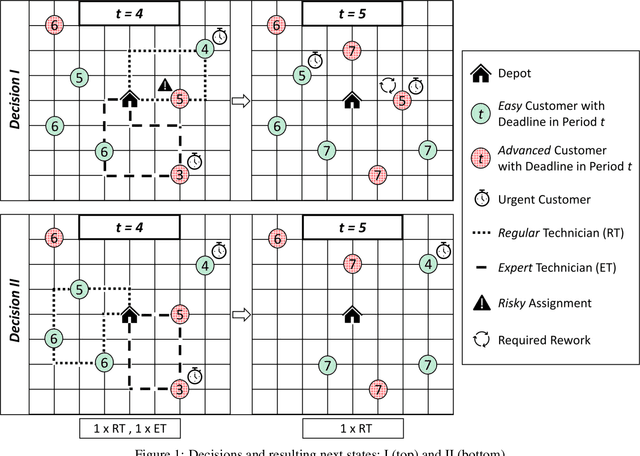



Abstract:Home repair and installation services require technicians to visit customers and resolve tasks of different complexity. Technicians often have heterogeneous skills and working experiences. The geographical spread of customers makes achieving only perfect matches between technician skills and task requirements impractical. Additionally, technicians are regularly absent due to sickness. With non-perfect assignments regarding task requirement and technician skill, some tasks may remain unresolved and require a revisit and rework. Companies seek to minimize customer inconvenience due to delay. We model the problem as a sequential decision process where, over a number of service days, customers request service while heterogeneously skilled technicians are routed to serve customers in the system. Each day, our policy iteratively builds tours by adding "important" customers. The importance bases on analytical considerations and is measured by respecting routing efficiency, urgency of service, and risk of rework in an integrated fashion. We propose a state-dependent balance of these factors via reinforcement learning. A comprehensive study shows that taking a few non-perfect assignments can be quite beneficial for the overall service quality. We further demonstrate the value provided by a state-dependent parametrization.
A Reinforcement Learning Environment for Directed Quantum Circuit Synthesis
Jan 13, 2024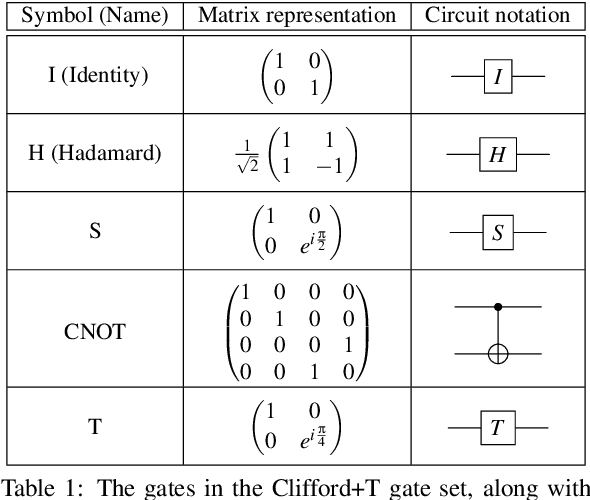
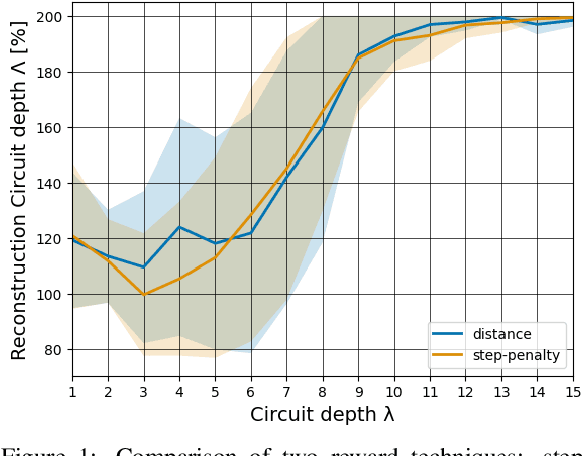
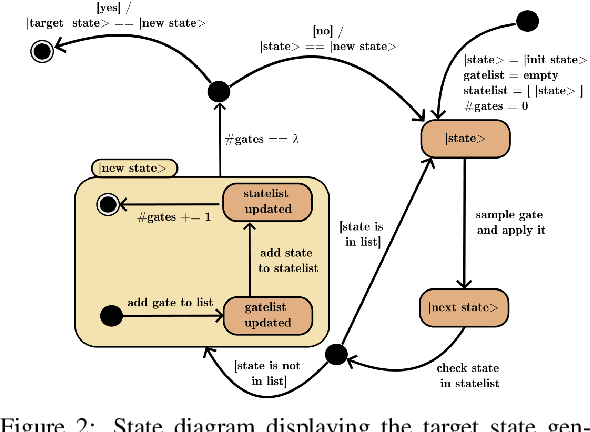
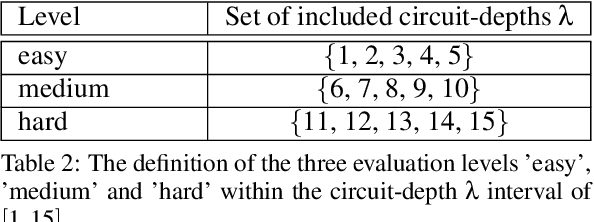
Abstract:With recent advancements in quantum computing technology, optimizing quantum circuits and ensuring reliable quantum state preparation have become increasingly vital. Traditional methods often demand extensive expertise and manual calculations, posing challenges as quantum circuits grow in qubit- and gate-count. Therefore, harnessing machine learning techniques to handle the growing variety of gate-to-qubit combinations is a promising approach. In this work, we introduce a comprehensive reinforcement learning environment for quantum circuit synthesis, where circuits are constructed utilizing gates from the the Clifford+T gate set to prepare specific target states. Our experiments focus on exploring the relationship between the depth of synthesized quantum circuits and the circuit depths used for target initialization, as well as qubit count. We organize the environment configurations into multiple evaluation levels and include a range of well-known quantum states for benchmarking purposes. We also lay baselines for evaluating the environment using Proximal Policy Optimization. By applying the trained agents to benchmark tests, we demonstrated their ability to reliably design minimal quantum circuits for a selection of 2-qubit Bell states.
Quantum Advantage Actor-Critic for Reinforcement Learning
Jan 13, 2024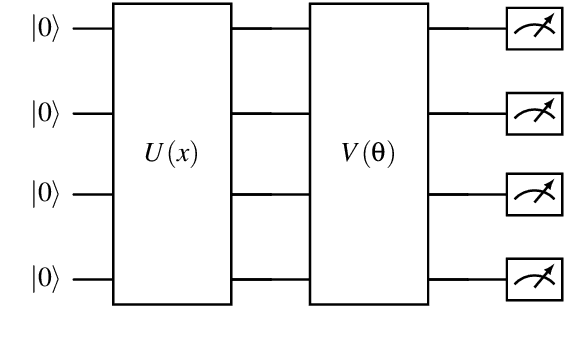
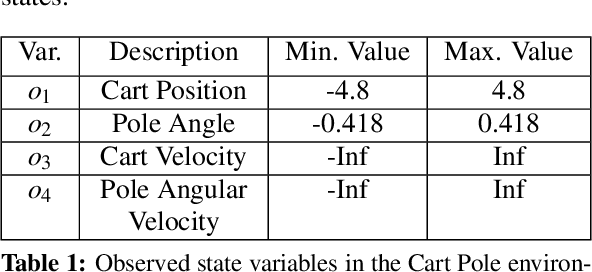

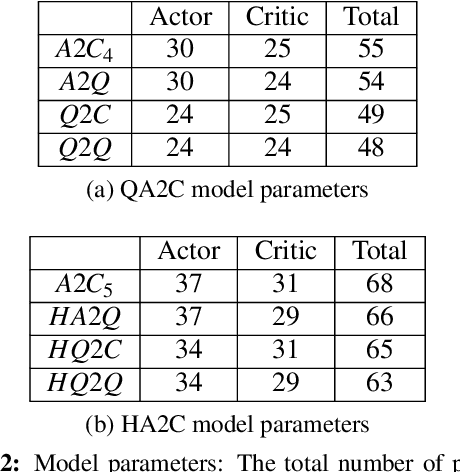
Abstract:Quantum computing offers efficient encapsulation of high-dimensional states. In this work, we propose a novel quantum reinforcement learning approach that combines the Advantage Actor-Critic algorithm with variational quantum circuits by substituting parts of the classical components. This approach addresses reinforcement learning's scalability concerns while maintaining high performance. We empirically test multiple quantum Advantage Actor-Critic configurations with the well known Cart Pole environment to evaluate our approach in control tasks with continuous state spaces. Our results indicate that the hybrid strategy of using either a quantum actor or quantum critic with classical post-processing yields a substantial performance increase compared to pure classical and pure quantum variants with similar parameter counts. They further reveal the limits of current quantum approaches due to the hardware constraints of noisy intermediate-scale quantum computers, suggesting further research to scale hybrid approaches for larger and more complex control tasks.
Quantum Denoising Diffusion Models
Jan 13, 2024



Abstract:In recent years, machine learning models like DALL-E, Craiyon, and Stable Diffusion have gained significant attention for their ability to generate high-resolution images from concise descriptions. Concurrently, quantum computing is showing promising advances, especially with quantum machine learning which capitalizes on quantum mechanics to meet the increasing computational requirements of traditional machine learning algorithms. This paper explores the integration of quantum machine learning and variational quantum circuits to augment the efficacy of diffusion-based image generation models. Specifically, we address two challenges of classical diffusion models: their low sampling speed and the extensive parameter requirements. We introduce two quantum diffusion models and benchmark their capabilities against their classical counterparts using MNIST digits, Fashion MNIST, and CIFAR-10. Our models surpass the classical models with similar parameter counts in terms of performance metrics FID, SSIM, and PSNR. Moreover, we introduce a consistency model unitary single sampling architecture that combines the diffusion procedure into a single step, enabling a fast one-step image generation.
Challenges for Reinforcement Learning in Quantum Computing
Dec 18, 2023Abstract:Quantum computing (QC) in the current NISQ-era is still limited. To gain early insights and advantages, hybrid applications are widely considered mitigating those shortcomings. Hybrid quantum machine learning (QML) comprises both the application of QC to improve machine learning (ML), and the application of ML to improve QC architectures. This work considers the latter, focusing on leveraging reinforcement learning (RL) to improve current QC approaches. We therefore introduce various generic challenges arising from quantum architecture search and quantum circuit optimization that RL algorithms need to solve to provide benefits for more complex applications and combinations of those. Building upon these challenges we propose a concrete framework, formalized as a Markov decision process, to enable to learn policies that are capable of controlling a universal set of quantum gates. Furthermore, we provide benchmark results to assess shortcomings and strengths of current state-of-the-art algorithms.
 Add to Chrome
Add to Chrome Add to Firefox
Add to Firefox Add to Edge
Add to Edge